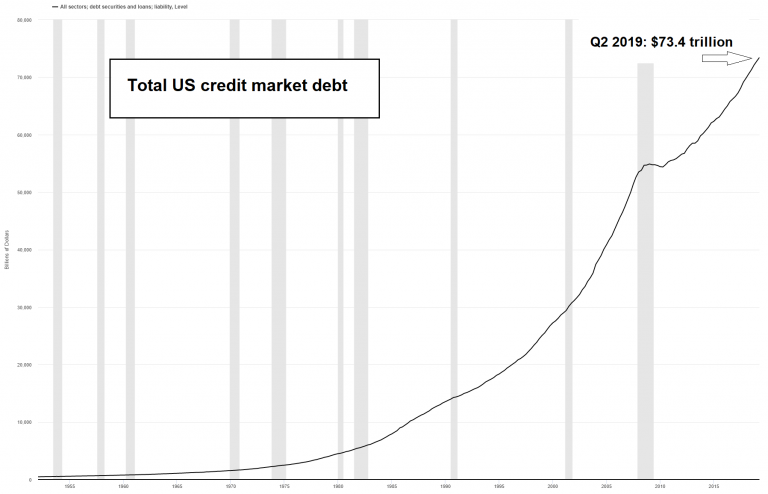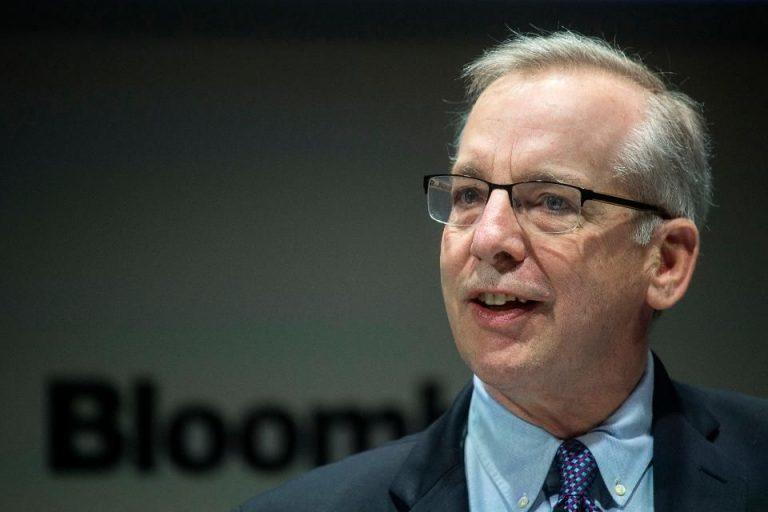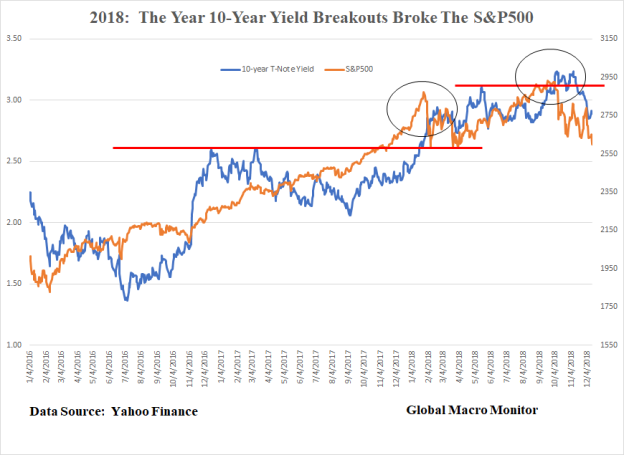
We present some somber reading on this holiday season from Macquarie Capital’s Viktor Shvets, who in this exclusive to ZH readers excerpt from his year-ahead preview, explains why central banks can no longer exit the “doomsday highway” as a result of a “dilemma from hell” which no longer has a practical, real-world resolution, entirely as a result of previous actions by the same central bankers who are now left with no way out from a trap they themselves have created.
* * *
“It has been said that something as small as the flutter of a butterfly’s wing can ultimately cause a typhoon halfway around the world” – Chaos Theory.
There is a good chance that 2018 might fully deserve shrill voices and predictions of dislocations that have filled almost every annual preview since the Great Financial Crisis.
Whether it was fears of a deflationary bust, expectation of an inflationary break-outs, disinflationary waves, central bank policy errors, US$ surges or liquidity crunches, we pretty much had it all. However, for most investors, the last decade actually turned out to be one of the most profitable and the most placid on record. Why then have most investors underperformed and why are passive investment styles now at least one-third (or more likely closer to two-third) of the market and why have value investors been consistently crushed while traditional sector and style rotations failed to work? Our answer remains unchanged. There was nothing conventional or normal over the last decade, and we believe that neither would there be anything conventional over the next decade. We do not view current synchronized global recovery as indicative of a return to traditional business and capital market cycles that investors can ‘read’ and hence make rational judgements on asset allocations and sector rotations, based on conventional mean reversion strategies. It remains an article of faith for us that neither reintroduction of price discovery nor asset price volatility is any longer possible or even desirable.
However, would 2018, provide a break with the last decade? The answer to this question depends on one key variable. Are we witnessing a broad-based private sector recovery, with productivity and animal spirits coming back after a decade of hibernation, or is the latest reflationary wave due to similar reasons as in other recent episodes, namely (a) excess liquidity pumped by central banks (CBs); (b) improved co-ordination of global monetary policies, aimed at containing exchange rate volatility; and (c) China’s stimulus that reflated commodity complex and trade?

The answer to this question would determine how 2018 and 2019 are likely to play out. If the current reflation has strong private sector underpinnings, then not only would it be appropriate for CBs to withdraw liquidity and raise cost of capital, but indeed these would bolster confidence, and erode pricing anomalies without jeopardizing growth or causing excessive asset price displacements. Essentially, the strength of private sector would determine the extent to which incremental financialization and public sector supports would be required. If on the other hand, one were to conclude that most of the improvement has thus far been driven by CBs nailing cost of capital at zero (or below), liquidity injections and China’s debt-fuelled growth, then any meaningful withdrawal of liquidity and attempts to raise cost of capital would be met by potentially violent dislocations of asset prices and rising volatility, in turn, causing contraction of aggregate demand and resurfacing of disinflationary pressures. We remain very much in the latter camp. As the discussion below illustrates, we do not see evidence to support private sector-led recovery concept. Rather, we see support for excess liquidity, distorted rates and China spending driving most of the improvement.
We have in the past extensively written on the core drivers of current anomalies. In a ‘nutshell’, we maintain that over the last three decades, investors have gradually moved from a world of scarcity and scale limitations, to a world of relative abundance and an almost unlimited scalability. The revolution started in early 1970s, but accelerated since mid-1990s. If history is any guide, the crescendo would occur over the next decade. In the meantime, returns on conventional human inputs and conventional capital will continue eroding while return on social and digital capital will continue rising. This promises to further increase disinflationary pressures (as marginal cost of almost everything declines to zero), while keeping productivity rates constrained, and further raising inequalities.
The new world is one of disintegrating pricing signals and where economists would struggle even more than usual, in defining economic rules. As Paul Romer argued in his recent shot at his own profession, a significant chunk of macro-economic theories that were developed since 1930s need to be discarded. Included are concepts such as ‘macro economy as a system in equilibrium’, ‘efficient market hypothesis’, ‘great moderation’ ‘irrelevance of monetary policies’, ‘there are no secular or structural factors, it is all about aggregate demand’, ‘home ownership is good for the economy’, ‘individuals are profit-maximizing rational economic agents’, ‘compensation determines how hard people work’, ‘there are stable preferences for consumption vs saving’ etc. Indeed, the list of challenges is growing ever longer, as technology and Information Age alters importance of relative inputs, and includes questions how to measure ‘commons’ and proliferating non-monetary and non-pricing spheres, such as ‘gig or sharing’ economies and whether the Philips curve has not just flattened by disappeared completely. The same implies to several exogenous concepts beloved by economists (such as demographics).
The above deep secular drivers that were developing for more than three decades, but which have become pronounced in the last 10-15 years, are made worse by the activism of the public sector. It is ironic that CBs are working hard to erode the real value of global and national debt mountains by encouraging higher inflation, when it was the public sector and CBs themselves which since 1980s encouraged accelerated financialization. As we asked in our recent review, how can CBs exit this ‘doomsday highway’?
Investors and CBs are facing a convergence of two hurricane systems (technology and over-financialization), that are largely unstoppable. Unless there is a miracle of robust private sector productivity recovery or unless public sector policies were to undergo a drastic change (such as merger and fiscal and monetary arms, introduction of minimum income guarantees, massive Marshall Plan-style investments in the least developed regions etc), we can’t see how liquidity can be withdrawn; nor can we see how cost of capital can ever increase. This means that CBs remain slaves of the system that they have built (though it must be emphasized on our behalf and for our benefit).
If the above is the right answer, then investors and CBs have to be incredibly careful as we enter 2018. There is no doubt that having rescued the world from a potentially devastating deflationary bust, CBs would love to return to some form of normality, build up ammunition for next dislocations and play a far less visible role in the local and global economies. Although there are now a number of dissenting voices (such as Larry Summers or Adair Turner) who are questioning the need for CB independence, it remains an article of faith for an overwhelming majority of economists. However, the longer CBs stay in the game, the less likely it is that the independence would survive. Indeed, it would become far more likely that the world gravitates towards China and Japan, where CB independence is largely notional.
Hence, the dilemma from hell facing CBs: If they pull away and remove liquidity and try to raise cost of capital, neither demand for nor supply of capital would be able to endure lower liquidity and flattening yield curves. On the other hand, the longer CBs persist with current policies, the more disinflationary pressures are likely to strengthen and the less likely is private sector to regain its primacy.
We maintain that there are only two ‘tickets’ out of this jail. First (and the best) is a sudden and sustainable surge in private sector productivity and second, a significant shift in public sector policies. Given that neither answer is likely (at least not for a while), a coordinated, more hawkish CB stance is akin to mixing highly volatile and combustible chemicals, with unpredictable outcomes.
Most economists do not pay much attention to liquidity or cost of capital, focusing almost entirely on aggregate demand and inflation. Hence, the conventional arguments that the overall stock of accommodation is more important than the flow, and thus so long as CBs are very careful in managing liquidity withdrawals and cost of capital raised very slowly, then CBs could achieve the desired objective of reducing more extreme asset anomalies, while buying insurance against future dislocation and getting ahead of the curve. In our view, this is where chaos theory comes in. Given that the global economy is leveraged at least three times GDP and value of financial instruments equals 4x-5x GDP (and potentially as much as ten times), even the smallest withdrawal of liquidity or misalignment of monetary policies could become an equivalent of flapping butterfly wings. Indeed, in our view, this is what flattening of the yield curves tells us; investors correctly interpret any contraction of liquidity or rise in rates, as raising a possibility of more disinflationary outcomes further down the road.
Hence, we maintain that the key risks that investors are currently running are ones to do with policy errors. Given that we believe that recent reflation was mostly caused by central bank liquidity, compressed interest rates and China stimulus, clearly any policy errors by central banks and China could easily cause a similar dislocation to what occurred in 2013 or late 2015/early 2016. When investors argue that both CBs and public authorities have become far more experienced in managing liquidity and markets, and hence, chances of policy errors have declined, we believe that it is the most dangerous form of hubris. One could ask, what prompted China to attempt a proper de-leveraging from late 2014 to early 2016, which was the key contributor to both collapse of commodity prices and global volatility? Similarly, one could ask what prompted the Fed to tighten into China’s deleveraging drive in Dec ’15. There is a serious question over China’s priorities, following completion of the 19th Congress, and whether China fully understands how much of the global reflation was due to its policy reversal to end deleveraging.
What does it mean for investors? We believe that it implies a higher than average risk, as some of the key underpinnings of the investment landscape could shift significantly, and even if macroeconomic outcomes were to be less stressful than feared, it could cause significant relative and absolute price re-adjustments. As highlighted in discussion below, financial markets are completely unprepared for higher volatility. For example, value has for a number of years systematically under performed both quality and growth. If indeed, CBs managed to withdraw liquidity without dislocating economies and potentially strengthening perception of growth momentum, investors might witness a very strong rotation into value. Although we do not believe that it would be sustainable, expectations could run ahead of themselves. Similarly, any spike in inflation gauges could lift the entire curve up, with massive losses for bondholders, and flowing into some of the more expensive and marginal growth stories.

While it is hard to predict some of these shorter-term moves, if volatilities jump, CBs would need to reset the ‘background picture’. The challenge is that even with the best of intentions, the process is far from automatic, and hence there could be months of extended volatility (a la Dec’15-Feb’16). If one ignores shorter-term aberrations, we maintain that there is no alternative to policies that have been pursued since 1980s of deliberately suppressing and managing business and capital market cycles. As discussed in our recent note, this implies that a relatively pleasant ‘Kondratieff autumn’ (characterized by inability to raise cost of capital against a background of constrained but positive growth and inflation rates) is likely to endure. Indeed, two generations of investors grew up knowing nothing else. They have never experienced either scorching summers or freezing winters, as public sector refused to allow debt repudiation, deleveraging or clearance of excesses. Although this cannot last forever, there is no reason to believe that the end of the road would necessarily occur in 2018 or 2019. It is true that policy risks are more heightened but so is policy recognition of dangers.
We therefore remain constructive on financial assets (as we have been for quite some time), not because we believe in a sustainable and private sector-led recovery but rather because we do not believe in one, and thus we do not see any viable alternatives to an ongoing financialization, which needs to be facilitated through excess liquidity, and avoiding proper price and risk discovery, and thus avoiding asset price volatility.
Source: ZeroHedge


























